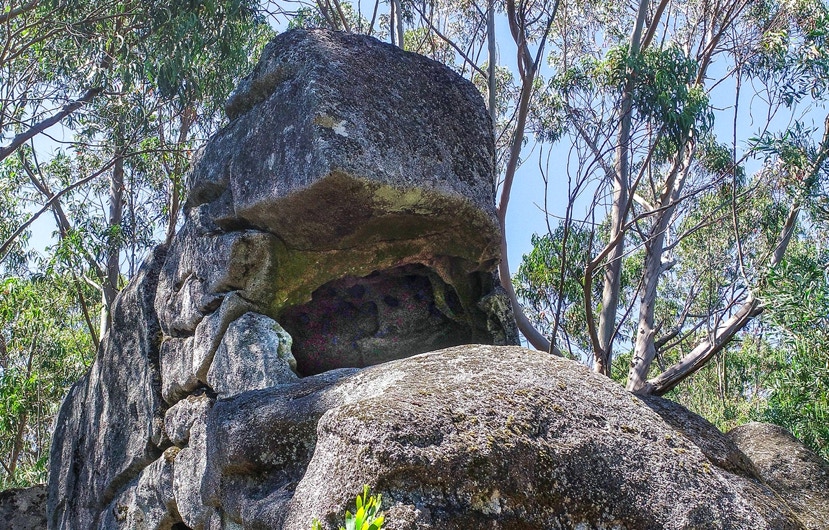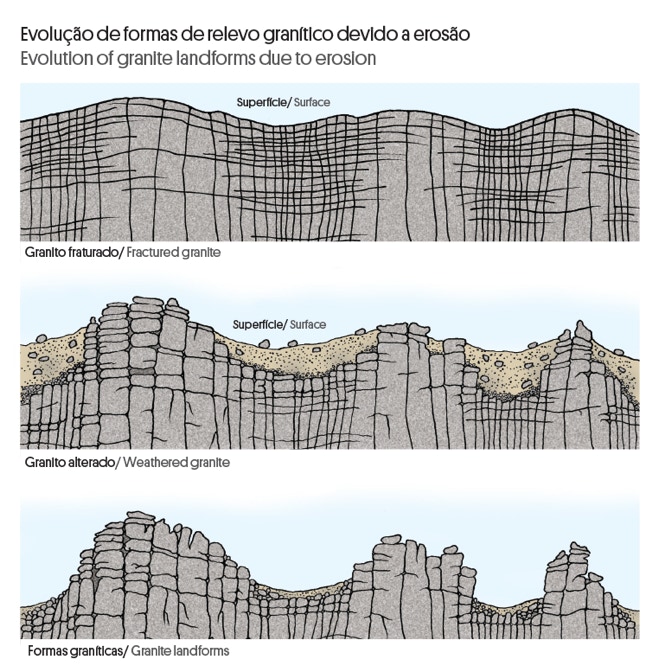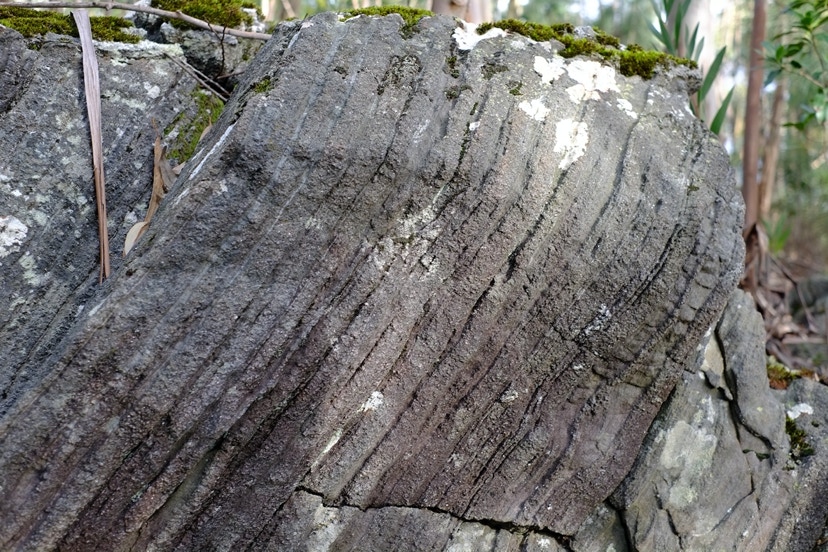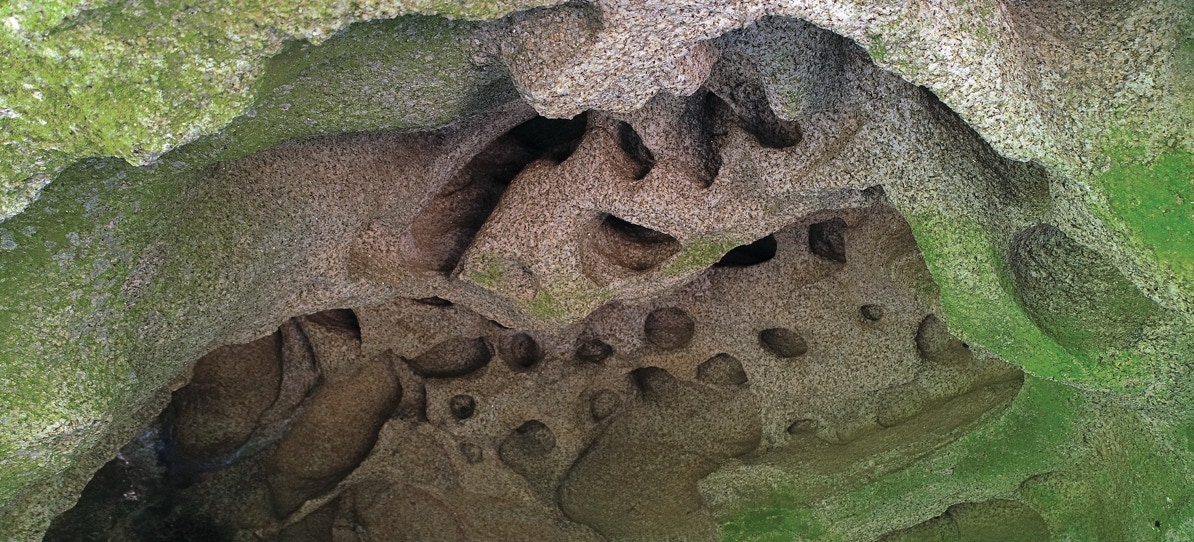The mistery of Penedo Furado of Monte da Meadela
Rocks, when exposed to the action of water, air, and others, undergo a series of physical and chemical processes which modify their minerals. As a consequence, rocks become less cohesive and changes in their colour frequently take place. These series of transformations are called weathering. Rocks become more fragile and less cohesive after weathering and are dismantled by a process known as erosion. As a consequence, landforms of different scales arise.
In rare circumstances that are not yet understood, rocks decay forming small cavities that look like a honeycomb. These cavities are called tafoni (word of Italian origin that means breach or window). Here, at Penedo Furado, the phenomenon is even more peculiar since tafoni have developed inside the granite block!
Penedo Furado is a granite block 7 m long, 3.5 m wide, 3.5 m high, and with an approximate volume of 55 m3 (Fig. 5.1). Its inner cavity corresponds to about 9 m3 of rock that has already been eroded, a process that is still going on.

Figure 7.1. Penedo Furado of Meadela.
The origin and development of this landform seem to be related to weathering, when a chemical process below the topographic surface took place, in association with the granite network of fractures (Figs. 7.2 and 7.3).

Figure 7.2. Typical granite weathering profile conditioned by fractures (Ruxton & Berry, 1957, in Migon, 2006, Granite Landscapes of the World, Oxford University Press).

Figure 7.3. Evolution of granite landforms due to erosion.
The inside and top walls of Penedo Furado are entirely filled by small well individualized alveoli which sometimes coalesce giving rise to a typical form known as honey comb (Fig. 7.4).

Figure 7.4. “Honey comb” surface inside Penedo Furado block.
The exposure of this landform results from the removal of the disaggregated overlying rock due to erosion, a process common to many granitic areas. Near the base of the tafone it is possible to identify the fallen block that initially held the cavity more isolated.
A little more about the origin of tafoni…
The origin and development of tafoni is still a subject of discussion in the scientific community, being attributed to various processes and mechanisms. However, it is already known that some originate due to the action below the surface of soil moisture on the rock. Alternatively, many tafoni appear to originate and develop at the surface due to weathering. The development / enlargement of the cavities originates from the inside of the tafoni, and may, in the limit, lead to the rupture of its outer “cover”. Variations in temperature, freezing and thawing of water and salt crystallization, among others, may be some of the factors responsible for cavities enlargement. Over time, the outer casing may even eventually rupture. In figure 7.5 different stages of development of a tafone can be observed.

Figure 7.5. Development stages of a tafone.
So close to Penedo Furado but so different...
In this Local Natural Monument, there are other curious aspects to observe! Let’s check the metamorphic rock that is very near Penedo Furado block.
Although they are close to each other, rocks might be the result of different geological processes with very different ages. Granites in this region formed about 300 million years ago but these metamorphic rocks are even older: they are about 500 million years old! Besides the age difference, they have formed in a completely different way compared with granites.
These metamorphic rocks began to be formed when sand (sediments) were transported and deposited by water forming horizontal layers (Fig. 7.6).

Figure 7.6. Parallel bedding that was originally horizontal but now inclined due to tectonic action.
The transport of sediments sometimes gives rise to sand waves that accumulate on top of one another, forming overlapping concave structures called cross bedding (Fig. 7.7). Later, these sediments gave rise to a compact and hardened sedimentary rock, imprinted with the record of these sand waves (Fig. 7.8). Finally, this rock was transformed by heat and pressure into the metamorphic rock that exists today in this place.

Figure 7.7. Development of cross bedding due to the transport of sediments.

Figure 7.8. In this LNM, the cross bedding in the metamorphic rock is a proof of its sedimentary origin.
In the same place are also visible folds that affect the stratification (Fig. 7.9). This rock deformation is related to the compressive forces that around 300 million years ago led to: i) closure of the primitive ocean where these and other ancient sedimentary rocks formed, and ii) formation of a mountain range. During this long-time span, this mountain range has been eroded but some evidences of its existence are still here!

Figure 7.9. Layers of rock originally of sedimentary origin showing folding due to tectonic forces.









